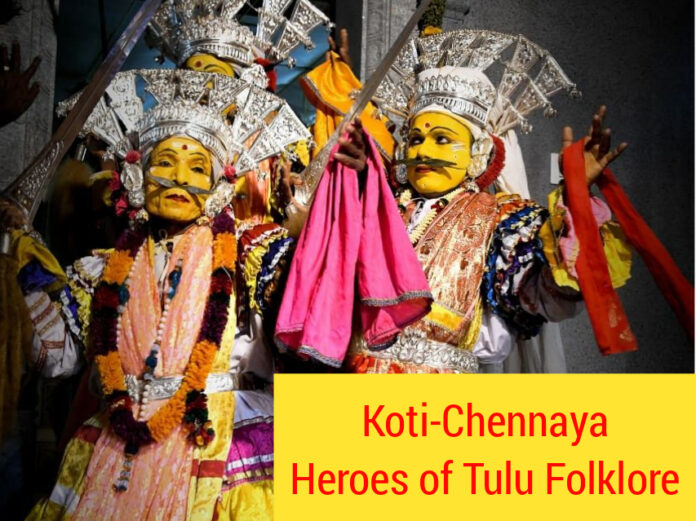This is Part VI of the 14 part Koti- Chennaya series
Part V Part IV Part III Part II Part I
[Note by the translator: The twin daivas(spirits) of Koti and Chennaya are one of the most popular folk deities of Tulunadu. Along with other daivas or bhutas such as Kallurti, Bobbarya, Maisandaya, Alibhuta, Koragajja, etc., Koti-Chennaya get venerated in the length and breadth of the Tulu region. Numerous studies suggest that most daivas are reminiscent of the folk heroes of that name, who were subjected to oppression of different sorts to maintain the hierarchical status-quo of the traditional Tulunadu. When they became mayaka (or perished fighting that oppression), they started getting venerated. Being born in the Billava¹ caste, Koti-Chennaya were subjected to constant treachery and harassment, even though they came close to power centres. It is roughly estimated that the twin brothers lived in the seventeenth or the eighteenth century. The following story of Koti and Chennaya is a translation based on the story written by Shri Panje Mangesha Rao, an early litterateur in Kannada. Panje himself got several (Tulu) versions of the story – one of them from Hermann Moegling of the Basel Mission. Comparing and contrasting, he finally arrived at the following story in the early twentieth century.]
Thus, Koti-Chennaya started to spend their days happily in their sister’s house. However, their news gradually spread throughout Panja. People even started to go to Payya Baidya’s house to see for themselves the bodily wealth of the twin men –the manly face, wide chest, slim body, agile hands – all these used to make them dumb founded. The brothers were initially home bound. However, as they met with people around, and made friends with a few of them, they started moving about the village with confidence. The news of the twin brothers reached Kemara Ballala too. He was very happy to hear about the cleverness of their mind and the strength of their body. However, gradually the praise started turning bitter. One Chendugidi was the main reason in turning his mind.
Kemara Ballala and Chendugidi grew up eating on the same plate; they studied in the same garadi [1] ; fought on the same platform. When Chendugidi was a youngster, the elderly Ballala of Panja passed away. Subsequently, Kemara Ballala was coronated by the people of eight magane [2]. No sooner did the Ballala get coronated, than Chendugidi started experiencing an extreme sense of influence. When the elderly Ballala was in power, Payya Baidya was his right hand man. Chendugidi targeted the seat of Baidya from early on. Within two years of Kemara ascending the throne of Panja, Chendugidi made several allegations on Baidya and drove him away from beedu. Chendugidi occupied his position. Though Baidya was away from beedu, he was not so away from the Ballala. Kemara Ballala had it in his mind that Baidya was closer to his father’s heart. Chendugidi was looking for a time when he could bring perfect misunderstanding between the two so that Ballala hated Baidya. Now was the time for such an effort since Koti-Chennaya stayed in Baidya’s house.
Chendugidi did not like Koti-Chennaya staying in Payya Baidya’s house. Chendugidi was timid by nature. Other’s bravery would not appeal to him. By now he had already seen the dexterity of Chennaya – from his ability to deal with arrows to his skilfulness in playing flute – and was scared of him. Moreover, since he had intrigued Payya Baidya and now that Koti-Chennaya were staying with Payya Baidya himself, Chendugidi was afraid that Baidya may use the help of the twins to topple him and gain power once again. Therefore, Chendugidi thought the three – Kemara Ballala, Payya Baidya and the twin brothers – should never come together, lest their power get consolidated. Hence, the Ballala should never see Koti-Chennaya and their prowess. However, Chendugidi was crooked enough not to reflect what he thought either in words or on his face. On the other hand, Payya Baidya was innocent enough not to know the conspiracies of Chendugidi and would request him every day to arrange a meeting between his brothers-in-law and the Ballala. Koti-Chennaya too, were aspiring to meet the Ballala. Chendugidi, on the other hand, would postpone this meeting giving some or the other excuse every time. Baidya would return home and tell Koti-Chennaya “it wasn’t possible today. Let’s try next time.” Several months passed like this without the meeting taking place at all.
In Padumale, from the day Koti-Chennaya challenged Perumallu Ballala, the latter started growing highly restless. Every now and then he would get angry; swear and curse without reason. His servants searched around to catch and kill Koti-Chennaya. Thus, the servants who went in search of the brothers, had set their house afire. Except Sayina Baidya, no one was at home. The servants brought him to the Ballala. Baidya was tortured to extract information as to the whereabouts of Koti-Chennaya. Ballala’s wife saw the frail life of the old man writhing in pain and said “Why do you torture the old man? I can’t listen to his wailing. Release him.” Thereafter, the old man lived inside the fortified beedu providing the royal house with what he could – toddy. He earned their confidence, yet he was not permitted to go out of the fortification.
Perumaalu Ballala suffered acutely with obsessive thoughts about Koti-Chennaya. When he thought about the ultimatum they placed, he would become gloomy. When someone said they would not come back, he was happy. Sometimes he thought about them compassionately, thinking of them as the children of beedu, and of bringing them back strategically, wherever they were. Some other time, he thought of them as potential dangers and questioned his own wit in inviting risk by bringing them too close. Caught up continuously in these questions, his mind became utterly turbulent.
One of the servants who went in search of Koti-Chennaya came to know that they had gone to Panja. He came back to the beedu and gave his information to the Ballala about their whereabouts. The next day, Ballala called for his Senabova. [3]
The Senabova came with a bundle of palm leaves that were dried in the sun afresh. “My lord”, he called the Ballala. The latter took him to an inner room saying there was confidential work. Senabova pulled a palm-leaf out, trimmed both its ends, applied oil and turmeric, wrote ‘Sri’ [4] to begin with and then wrote whatever the Ballala dictated.Ballala put his signature and ordered “This should reach the Ballala of Panja”. Two messengers started off to Panja from Padumale on the same day.
Also read: In Pictures: Successful Nationwide Bharat Bandh by Farmers and Trade Unions
In Panja in the meanwhile, Chendugidi was lost in the thought that Koti-Chennaya were gaining all the limelight. He thought “They have cast a magic-spell on the whole village. The women are charmed; elderly are baffled. Why is it that there is no stoppage to the egotistic display of these Billava broods? The more I try to contain their information, the more it spreads! I’m afraid they will bewilder Kemara Ballala too!That will be my fall! As though it isn’t enough, Ballala can’t hear properly, an addict of bangi [5] too! Alas! I am out of ideas.” Just as he thought so, Ballala’s messengers arrived there and said, “You are required by the Ballala right now”. Chendugidi started off to the beedu instantaneously.
Kannada version by Shri Panje Mangesha Rao (“Koti Chennaya”, from Panjeyavara Kritigalu: Sanna Kathegalu mattu Kadambarigalu, Ed: Panje Ramaraya, Madras: Orient Longman Ltd, 1973)
Translated English version by Shashikantha Koudur (Professor in Humanities at National Institute of Technology Karnataka, Surathkal)
Glossary of Kannada and Tulu words
[1] Traditional school of martial arts in Tulunadu.
[2] An administrative division of territory.
[3] An employee of the clerical cadre.
[4] Most traditional writings began with a note ‘Sri’ in Sanskrit.
[5] Hemp or cannabis consumed in an indigenous way.




























Awesome compilation. Easy read. When can we expect the part 7 and more